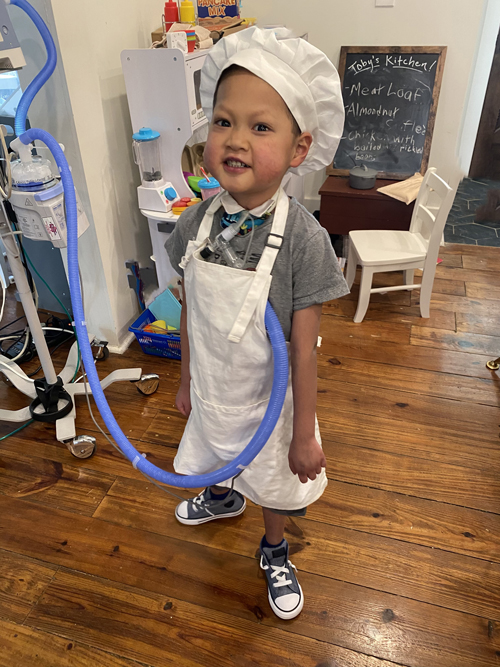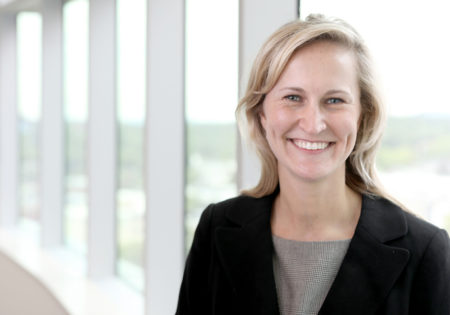by Nancy Humphrey
Brinkley Sandvall, MD, bonds quickly with her young patients — children who have acquired or congenital hand and upper extremity differences.

After extensive training as a reconstructive hand surgeon, she runs the Hand and Upper Extremity program at Monroe Carell Jr. Children’s Hospital at Vanderbilt.
“I feel like this is the greatest job — it’s the intersection of what I can do, what I want to do and what I feel compelled to do,” said Sandvall, who is fellowship-trained in pediatric hand and upper surgery and reconstructive microsurgery.
Six-year-old Toby Williams, described by his mother as joyful, hilarious, quirky and brave, connected quickly with Sandvall before surgery in March to clean out a deep infection that came on rapidly in his left hand and worked its way down to the bone.
Adopted at age 4 from China, Toby is no stranger to Children’s Hospital. He had surgery to repair a congenital heart defect about four months after he arrived in Nashville and was in the hospital’s Pediatric Critical Care Unit for 11 months. The hand infection was a “crazy random thing that happened,” said his mother, Amanda Williams, adding that a cause could never be pinpointed. “He’s super complex. The infection was pretty drastic.”
Sandvall, assistant professor of Plastic Surgery, came to Vanderbilt University Medical Center in October 2019. A graduate of Baylor University and Baylor College of Medicine, she completed her residency training in plastic and reconstructive surgery at the University of Washington in Seattle and a hand and upper extremity fellowship with the Department of Orthopaedic Surgery at Washington University in St. Louis followed by a second fellowship in pediatric hand and microvascular surgery fellowship at The Royal Children’s Hospital in Melbourne, Australia. She sees both adults and children at VUMC and Monroe Carell Children’s Hospital at Vanderbilt.

The children under her care have a wide range of issues including congenital differences, burns, tumors, neuromuscular disorders, vascular anomalies and traumatic injuries from accidents or playing sports.
She also sees families before children are born, when a congenital difference is noted on an ultrasound.
“It gives us the opportunity to provide information about what we do know, to talk about what we don’t yet know and to make a plan for once the child arrives,” Sandvall said. “Lots of parents wonder if it’s something they did wrong or should have done differently — and almost always the answer is no. Some conditions are hereditary, but most of them are sporadic. My job is to remove guilt and provide a diagnosis, a plan, some answers and some hope. I really love the opportunity to establish these relationships.”
Sandvall said repairing children’s hands can often be challenging because of continued growth and bone remodeling. If the growth plate is still open, it’s important to anticipate its effect when deciding whether to intervene or to wait.
“One of the challenges with very young children with nerve injuries from birth trauma is that we have to watch them over time and plot their trajectory and see what’s spontaneously recovering and what is not improving.”
Sandvall said she also believes part of her role is to support children when a visible difference can’t be “fixed” with surgery.
“I make sure children have an answer for when someone asks, ‘what happened to you’ or ‘why does your hand look like that?’ — and then have them practice it. When the child is the right age, I talk to them about how to speak about their difference matter of factly and simply, and even what to say when they’d prefer not to talk about it. I have them role play and rehearse it with me. I think it’s really powerful. Their attitudes and the words they use are more important than any operation I can do.”
Sandvall sees children in the hand and upper extremity clinic on the main campus as well as in Murfreesboro. She also sees pediatric patients in the multidisciplinary brachial plexus, vascular anomalies, cleft and craniofacial and spasticity clinics.
The infection in Toby’s hand is gone, and he has been following up with Sandvall in telehealth visits during the COVID-19 pandemic. “In the course of all of Toby’s medical concerns, the hand is minor,” his mother said. “But he’s still working on getting full range of motion back because of scar tissue. Toby and I both instantly loved Dr. Sandvall. She’s very personable and easy to talk to. Her presence is very calming.”












